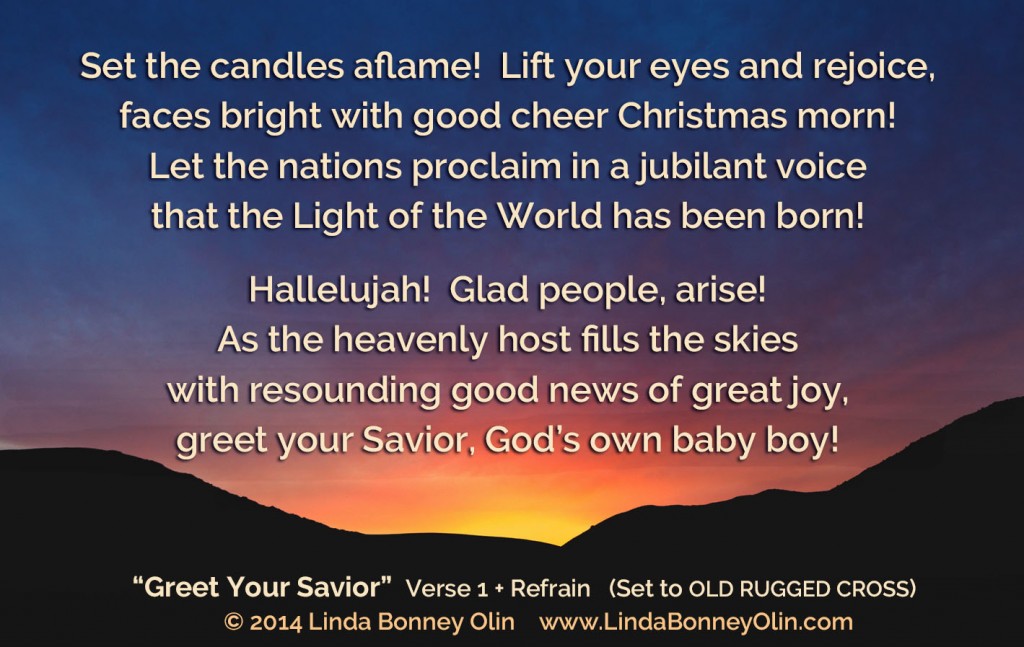 The Christmas song titled “Greet Your Savior” celebrates Jesus’ arrival with gusto! My words are set to the tune of “The Old Rugged Cross,” a popular old-time hymn.
The Christmas song titled “Greet Your Savior” celebrates Jesus’ arrival with gusto! My words are set to the tune of “The Old Rugged Cross,” a popular old-time hymn.
“Greet Your Savior” shows how new words can give a surprisingly different sound to a familiar tune. Part of the difference, of course, comes from singing it at a perkier tempo than you’d sing the contemplative lyrics of “The Old Rugged Cross.”
But a clever lyricist has other, less obvious, ways to influence the feel of a tune, without modifying the music one bit. I’ll let you in on a few of them, using OLD RUGGED CROSS as an example.
Side note: A hymn tune is the music. A hymn text is the words. The NAME IN CAPITAL LETTERS is the tune name. Naming texts and tunes separately is a helpful custom, because a good tune often is used as the musical setting for multiple texts, and a text may have several different musical settings to choose from.
First, listen to OLD RUGGED CROSS as it’s typically played with “The Old Rugged Cross.” Notice how the sequence of shorter and longer notes creates a rhythm, with natural pauses between chunks of music.
Here’s the first verse from “The Old Rugged Cross”:
1. On a hill far away stood an old rugged cross,
the emblem of suffering and shame;
and I love that old cross where the dearest and best
for a world of lost sinners was slain.
Refrain: So I’ll cherish the old rugged cross,
(cross, the old rugged cross)
till my trophies at last I lay down;
I will cling to the old rugged cross,
(cross, the old rugged cross)
and exchange it some day for a crown.
George Bennard, who wrote both the words and the music, used a basic ABCB rhyme scheme. In other words, the second and fourth lines rhyme with each other (shame/slain), but the first and third lines don’t rhyme.
See how the lyrics go on and on, all the way to the end of the verse, before finishing a rhyme? This pulls the singer along, subconsciously anticipating the closure of the rhyme. The longer you have to wait for the rhyme to be completed, the more drawn-out the tune feels. This is a good effect, if you’re going for a contemplative mood.
Each of Bennard’s verses is composed of a single sentence, too. There are no pesky periods interrupting his long, meditative thoughts.
So, both the rhyme and the thought are drawn out and completed together, at the end of the verse. Slow, but sure. Perfect for the mood of “The Old Rugged Cross.”
How about the refrain?
In addition to rhyming the second and fourth lines (down/crown), the refrain repeats the word cross at the end of the first and third lines. Not only that, but you may have noticed as you listened to the tune that each cross falls on a very long note. Ordinarily, this would cause the song to pause noticeably at each of those spots, interrupting the flow of the words. But Bennard overcame that obstacle with a nifty device.
While the singers on the melody line are holding out that cro-o-o-oss note, singers on the harmony lines sing the words in parentheses, echoing “old rugged cross.” This undercurrent carries you steadily onward to Bennard’s hope-filled final words, “and exchange it some day for a crown.”
Now, how does “Greet Your Savior” compare? Listen as you read the words.
OLD RUGGED CROSS (for “Greet Your Savior”)
1. Set the candles aflame! Lift your eyes and rejoice,
faces bright with good cheer Christmas morn!
Let the nations proclaim in a jubilant voice
that the Light of the World has been born!
Refrain: Hallelujah! Glad people, arise!
(people, people, arise!)
As the heavenly host fills the skies
with resounding good news of great joy,
(news, good news of great joy,)
greet your Savior, God’s own baby boy!
In contrast to “The Old Rugged Cross,” “Greet Your Savior” doesn’t make you wait till the end of a verse for the completion of a rhyme, or of a thought.
For starters, the rhyme scheme is ABAB instead of ABCB. Before you reach the fourth line’s rhyme with the second line (born/morn), you’ve already encountered the third line’s rhyme with the first (voice/joice).
On top of that, each pair of rhyming lines contains an extra rhyme (flame/claim, bright/Light). These mid-line rhyming syllables fall on long and/or high notes, emphasizing small, chunky phrases in both the music and the lyrics. Shorter phrases create punch.
The sentence structure adds zip too. Instead of a single long sentence, the first verse is divided into three distinct action-type sentences, each one punctuated with an exclamation point.
All this keeps your subconscious revved up, ready for the jubilant refrain.
Yes, I kept Bennard’s undercurrent of words for the harmony singers in the refrain. Why? Because I just plain like it. Not to worry, though; the refrain won’t drag. It features shorter sentences and rhymes that are completed quickly in an AABB rhyme scheme (arise/skies, joy/boy). Shorter + quicker = peppier.
Besides, who can sing a refrain beginning “Hallelujah!” with anything but gusto? 😀
Questions or comments? Please share them in the Reply box, below.
If you’d like to use “Greet Your Savior” in your church’s worship service or for personal enjoyment, please use the Contact Form to request sheet music for the full hymn (PDF).
Merry Christmas, hymn lovers—all year long!
Linda
